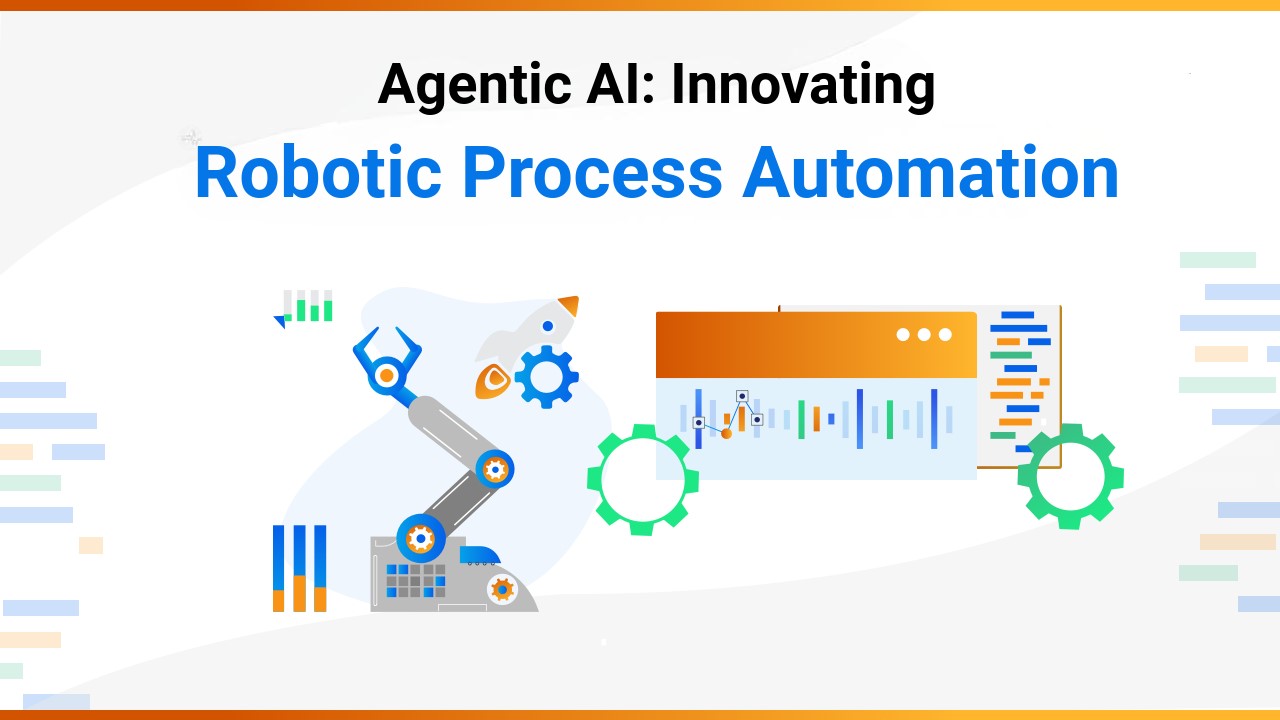Discover how AI agents are revolutionizing Robotic Process Automation (RPA) in manufacturing. By integrating AI with traditional automation, organizations can streamline complex workflows, enhance decision-making, and gain real-time insights. This blog explores the significant benefits of AI agents, including increased efficiency, reduced costs, and improved customer satisfaction, highlighting how innovations like Agentic AI are shaping the future of operational excellence in the industry.
How can organizations leverage automation for better efficiency? In an age where every second counts, manufacturing companies must find ways to enhance productivity while managing costs effectively. Robotic Process Automation (RPA) allows them to automate tedious tasks, which lets employees focus on higher-level responsibilities. Integrating AI Agents into RPA systems further enhances automation capabilities and provides real-time insights.
This blog discusses the significant role of these agents in RPA, particularly within this sector. Another focus will be on how Agentic AI improves operational efficiency and customer satisfaction through automation.
What is Robotic Process Automation?
Robotic Process Automation (RPA) involves deploying software or “bots” to automate rule-based tasks across diverse manufacturing applications. These tasks typically involve data entry, transaction processing, and other repetitive functions that require human input. This technology deals with issues of complexity within an organization, providing approaches to tackle operational risks and enhance service delivery. Its compatibility with existing systems makes it easily applicable to any manufacturing business.
A Brief Overview of AI Agents for Robotic Process Automation
Although the traditional RPA system is helpful in outlining the possibility of automating many manufacturing tasks, it has some drawbacks, like the issue connected with extremity and the scarcity of interaction with higher technologies. Organizations often struggle with managing exceptions and optimizing workflows because these systems rely heavily on predefined rules.
AI agents delegate a unique shift in RPA by integrating intelligence and adaptability in tactical exploration. These agents can analyze and learn from past data and make independent decisions to enhance automation beyond basic task execution. These AI teammates work in tandem with RPA to monitor complex production processes and handle all the unexpected situations that require decision-making. Such integration marks a great leap forward in the automation environment, solving the problem of typical RPA shortcomings and preparing manufacturing enterprises for future challenges.
Traditional RPA vs. Agentic AI Robotic Process Automation
| Feature | Traditional RPA | Agentic AI-Based RPA |
| Intelligence | Rule-based automation | Learns and adapts over time |
| Task Complexity | Simple, repetitive tasks | Complex processes requiring decision-making |
| Integration | Limited to existing workflows | Seamless integration with AI capabilities |
| Scalability | Hard to scale for complex tasks | Easily scalable with multiagent systems |
| Response to Exceptions | Requires human intervention | Handles exceptions autonomously |
| Operational Efficiency | Moderate efficiency gains | Significant efficiency improvements |
Agentic AI Multi-Agent in Action
AI agents facilitate Robotic Process Automation (RPA) in several key ways:
- Automation of Complex Workflows: Through autonomous agents, it is possible to complete simple and elaborate processes and workflows, respectively. It allows organizations to streamline processes that involve multiple steps and decision points, significantly reducing cycle times.By managing these complex workflows, the agents free up human resources for more strategic activities, ultimately driving business growth.
- Real-Time Data Analysis: These agents function in real-time, and therefore allow organizations to process large volumes of information and make faster decisions. This ability is useful in search of perceived positions of weaknesses and opportunities for improvements. It helps businesses react quickly to changes in market conditions, customer needs, or internal processes.
- Collaboration in Multiagent Systems: AI agents work together within multiagent systems to optimize workflows, ensuring tasks are executed efficiently and accurately. This collaborative approach allows for the division of labor among specialized agents, each focusing on specific aspects of a process. By working in harmony, they can address complex challenges more effectively than individual systems could.
- Enhanced Insights: Agentic AI integration helps understand the limitations and opportunities within the functioning of an organization. Through these advanced analytics, organizations can gain better insight into their processes. This information not only raises performance but also drives improvement initiatives.
- Adaptability: The automation process constantly acquires better characteristics in terms of flexibility and adaptability to the new conditions required by the business, which translates into better correspondence of the process to the organization’s objectives.
These agents can easily update with new or modified information/conditions. This is an important feature in today’s working environment, where flexibility is the main key to success.
Use Cases of Robotic Process Automation
- Automated Order Processing: AI agents streamline order management by automatically validating customer data and updating inventory. This reduces manual errors and speeds up fulfillment, enhancing customer satisfaction.
- Supplier Performance Monitoring: These agents continuously analyze supplier metrics to assess performance in real-time. By identifying issues early, organizations can proactively address delays and maintain a reliable supply chain.
- Predictive Maintenance: AI agents monitor machinery performance data to predict maintenance needs before failures occur. This proactive approach minimizes downtime and reduces repair costs, enhancing operational efficiency.
- Quality Control Automation: Integrated AI agents monitor production data in real-time, detecting defects as they arise. This allows for immediate corrective actions, improving product quality and reducing waste.
- Regulatory Compliance Monitoring: AI agents automate compliance checks by monitoring operations against regulatory standards. They flag potential issues, mitigate risks, and enhance stakeholder confidence in the organization’s practices.
How Agentic AI Optimizes Robotic Process Automation?
Agentic AI employs various specialized agents to optimize Robotic Process Automation. Some of the key agents utilized by Agentic AI include:
- Supplier Performance Monitor: Tracks vendor metrics to enhance supply chain efficiency and ensure timely deliveries. By providing insights into supplier performance, organizations can make informed decisions about vendor relationships, mitigating risks associated with delays or quality issues.
- Collaboration Facilitator: Streamlines interactions between automated processes and human operators. Acting as a translator, it improves user interactions and removes obstacles, fostering cooperation between technology and personnel.
- Cost Analysis System: Examines spending patterns to uncover cost-saving opportunities and optimize budget management. Detailed insights into financial data enable organizations to allocate resources more effectively, leading to significant savings.
- Compliance Checker: Ensures adherence to regulatory standards, reducing vulnerabilities associated with non-compliance. Automating compliance checks enhances stakeholder confidence and minimizes legal risks, promoting accountability.
- Feedback Analyzer: Collects user feedback to enhance automated processes and boost satisfaction. Analyzing insights allows organizations to make continuous improvements, creating a more effective and user-friendly automation environment.
Operational Benefits of AI Agents in Robotic Process Automation
Integrating AI agents into Robotic Process Automation offers several key benefits:
- Increased Efficiency: These agents reduce cycle times, that is, the time it takes to complete a task, thus lowering turnaround time.
- Enhanced Accuracy: By minimizing human error through intelligent decision-making capabilities, organizations can achieve higher-quality outputs.
- Scalability: These agents are very flexible to business needs, which makes it easier for organizations to scale up their automation needs.
- Cost Reduction: Autonomous agents greatly lower labor costs associated with repetitive tasks, leading to overall cost savings.
- Improved Compliance: Automated monitoring guarantees compliance with rules and legislation, hence preventing organizations from legal risks.
- Better Customer Experience: Better response times and higher service quality translate to better response rates and more customers, respectively.
Technologies Transforming in Robotic Process Automation
The manufacturing industry is undergoing a transformation with the adoption of AI agents in Robotic Process Automation. Technologies such as multiagent frameworks allow for the coordination of various agents, effectively managing complex operations. These frameworks enable:
- Machine Learning Algorithms: These algorithms learn from a data set to find features and evolve from one version to another. Thus, as more data is accumulated, manufacturers can make more informed decisions about the processes involved in manufacturing, the resources needed for the process, and the quality control of the products that they produce.
- Predictive Analytics: This process involves the use of statistical models and artificial intelligence to identify trends and possible hazards in advance. By analyzing historical data and customer behavior, companies can develop effective strategies to optimize operations.
- Natural Language Processing (NLP): NLP enables autonomous agents to interpret and analyze textual data from sources such as customer feedback and market reports. This insight into sentiments and trends helps manufacturers make relevant decisions in line with the current prevailing market situations.
- AI Guardrails: AI guardrails help to tighten security at every level and maintain safety and non-inevitable data leakage during the automation of important processes. They prevent organizations from drifting too far from the kind of automated processes that are acceptable to regulators or even the industry at large – or from accidentally or deliberately exposing sensitive data to harm.
- Real-Time Data Processing: These agents are capable of real-time analysis of data with regard to metrics of production and other conditions within the markets, thus improving decision-making processes. Specifically, this capability allows manufacturers to respond quickly and effectively to change since tasks and processes can be redesigned with frequency and ease.
Future Trends in AI Agents for Robotic Process Automation
As the technology landscape continues to evolve, several trends are emerging in the realm of AI agents for Robotic Process Automation:
- Integration of Machine Learning: The increasing use of machine learning capabilities allows these agents to learn from historical data and improve performance over time, making them more effective in decision-making.
- Rise of Autonomous Agentic AI Systems: These systems enable agents to operate independently and arrive at decisions that do not involve human beings, thus enhancing the level of automated operational status in a system.
- Focus on Workflow Optimization: Organizations are prioritizing workflow optimization, driving demand for intelligent automation solutions that can adapt to changing business environments.
- Sophisticated AI Agents: The emergence of autonomous agents will result in the subsequent construction of still more complex autonomous systems for solving problems in various disciplines.
- Enhanced Decision-Making: With the continued development of these agents, it will be easier to come up with better decisions in organizations, hence the strategic planning.
- Increased Efficiency: As AI technology advances over time, robotics for the purpose of process automation is bound to improve; hence, the efforts will be a plus for organizations.
Conclusion: AI Agent for Robotic Process Automation
The incorporation of AI agents into RPA is an innovation that is changing the face of businesses, especially manufacturing firms. In this way, they provide improvements to the efficiency, accuracy, and flexibility that allow organizations to adapt the working processes to the constantly changing market environment. As technologies continue to evolve, the potential for these agents to transform RPA will only grow, offering organizations innovative solutions to meet their operational challenges. Embracing these advancements will be crucial for businesses aiming to maintain a competitive edge in today’s fast-paced environment.



